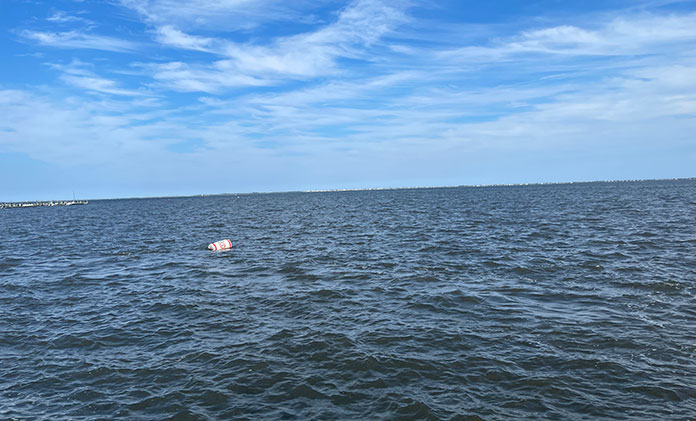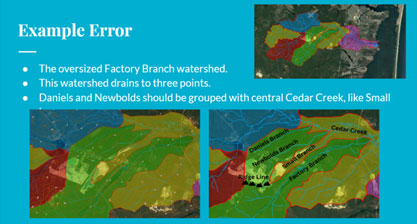
BARNEGAT BAY – A 23-year-old Stockton University senior has successfully completed a groundbreaking project to redraw subwatershed boundaries throughout the Barnegat Bay Watershed Management Area.
Forrest Jennings of Lacey undertook the Barnegat Bay Subwatersheds Redelineation Project with the support of a grant provided by Save Barnegat Bay. Over the course of the project, Jennings committed a remarkable 180 hours in identifying and potentially rectifying inaccuracies in the digital state GIS data.
“Once the report is published by Save Barnegat Bay, my hope is the state will see it and use what I have to fix their own maps,” said Jennings. “Not only for Barnegat Bay, but for all the other twenty watershed management areas throughout the state.”
The Barnegat Bay is New Jersey’s largest body of water located entirely within the state, with a watershed population of around 560,000, equivalent to that of Wyoming. It is also home to various forms of wildlife, and a vital hub for fisheries, recreation, science, and water supply, contributing approximately $4 billion annually to the region.
As a child, Jennings developed a deep passion for exploring the Pine Barrens, where he became intimately acquainted with the region’s hills and rivers. He said he was surprised when he examined the state’s mapping of its watersheds, particularly in the Cedar Creek region.
“I knew what the hills really looked like in real life,” Jennings shared. “And I knew that the state’s version of the watersheds wasn’t right for that area. I decided I should fix them.”
Watersheds are areas where water drains together, often separated by elevation changes. They can be as large as continents or as small as puddles. Mapping watersheds helps in understanding water flow, as well as aiding in pollution response and impact assessment.

Local issues like those experienced by Ciba Geigy’s contamination are significantly aided by accurate watershed mapping, which helps track polluted water and assess its impact on communities. Additionally, these maps enable informed decisions related to ecosystem health, species habitats, and drainage control in development projects.
When Jennings reviewed the state’s map of the subwatersheds of Barnegat Bay, he found fifteen areas identified by unique hydrologic unit codes (HUC). They have such names as the Metedeconk River, Toms River, Kettle Creek, Cedar Creek, Forked River, Oyster Creek, Waretown Creek, Mill Creek, Cedar Creek, Westecunk Creek, Tuckerton Creek, the barrier islands, and many other smaller tributaries.
“The accuracy is questionable, to say the least,” said Jennings. “Not all watersheds flow to one area. While some are on the map, many were drawn incorrectly. Adjacent streams are grouped together as one watershed when they were actually separated by elevation rises.”
Jennings pointed out one of the first examples of the errors pertained to Cedar Creek, which is in the middle of Barnegat Bay. The focus is on the Factory Branch Watershed and appears to drain into three different points. This goes against the fundamental principles of watersheds, which are divided by elevations and should drain to one point.
The state’s map groups Daniels Branch, Newbold Branch, and Factory Branch together even though they drain to separate points. Jennings decided there were several options in correcting just that one error.
Jennings’ renderings ensure that all watersheds flow to one point. He realigned some of the branches into one watershed and created an additional watershed in front of the Factory Branch.
The proposed changes will meet federal standards, which Jennings contends the state’s data fails to do under its current delineations.
As the student delved deeper into the project, he discovered a number of other errors. Jennings decided the best way of correcting the errors was to erase the state’s data and redo the maps himself. He began with an assessment of all of the 84 watersheds in the Barnegat Bay Watershed Management area, which he contends should actually be changed to 86 in total.
Rather than map the watersheds by sight, Jennings was able to take advantage of online mapping tools and software that contained a watershed tool. He also made sure he understood the pertinent federal guidelines.
“In total, I ended up creating three new watersheds,” Jennings shared. “I had to remove one that was split between two of its neighbors.”
“Of the 79 drains into the bay itself, all of them ended up being modified,” continued Jennings. “All of them ended up having different boundaries, with not a single one staying the same.”
Jennings concluded there were at least ten critical changes that should be made to the state’s map of the Barnegat Bay Watersheds. These revisions include correcting watershed boundaries, addressing misclassified areas along the boundaries, and resolving issues with specific branches and creeks. Suggested changes provide a more precise and comprehensive understanding of the watershed’s layout and drainage patterns.
Britta Forsberg, the Executive Director of Save Barnegat Bay, commended Jennings for the work he did as far as research and suggestions for an improved mapping system.

“At some point, the state as part of their watershed management planning was changing some of the delineations for the receiving units in the bay,” said Forsberg. “There were nine assessment units for the receiving water body in the bay. Save Barnegat Bay was on the public record about being upset about that.”
“Because if you’re making TMDLs or total maximum daily loads, you’re looking at reductions in pollution,” Forsberg continued. “And normally that pollution is likely coming from the land.”
Ultimately, the pollution makes its way to the water body and flows downstream from its respective watershed. The map therefore represents an essential tool for reducing pollution heading towards the bay.

Forsberg confirmed that Jennings’ findings and recommendations would be forwarded to the state for review. The end result would certainly impact the collective management of the Barnegat Bay.
The Save Barnegat Bay Student Grant Program is a way in which undergraduate students and rising undergraduate students can gain valuable research experience, while “giving back to Barnegat Bay.”






